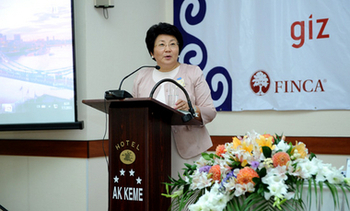Promotion of Microfinance in Central Asia
Project description
Title: Promotion of Microfinance in Central Asia, regional
Commissioned by: German Federal Ministry for Economic Cooperation and Development (BMZ)
Country: Kyrgyzstan, Tajikistan, Uzbekistan
Lead executing agency: Central banks of the three countries: National Bank of the Kyrgyz Republic, National Bank of Tajikistan, Central Bank of the Republic of Uzbekistan
Overall term: 2008 to 2013
Context
Broad-based economic development that is socially balanced, sustainable and covers a large geographic area presupposes access to financial services. Microfinance – financial services for clients who are not traditionally considered credit-worthy – has seen dynamic development in the countries of Central Asia. However, few microfinance institutions (MFIs) offer savings accounts, and loans often do not correspond to the demand from micro-enterprises or agriculture. The development of new products and sales channels calls for investments that exceed the possibilities of individual institutes, and urgently needed training courses are few and far between. Associations, service providers and interest groups are still in their infancy. In addition, the financial crisis has made it more difficult to gain access to credit lines (the most frequent source of funds from which microfinance institutions grant loans), or has led to them drying up altogether. Even before the financial crisis, the state had also begun to take an interest in the microfinance sector, both as a regulator and increasingly as a promoter of the economy.
Objective
The infrastructure of the microfinance sector is strengthened. The central banks acquire greater competencies and performance capacity to regulate and monitor the microfinance sector.
Approach
The project focuses on promoting the framework conditions of the microfinance sectors in Kyrgyzstan, Tajikistan and Uzbekistan. The central banks receive support for adjusting the legal frameworks, a process in which business associations also have a say.
Business associations are important actors in this sector. Their services and lobbying activities influence the direction and speed of sector development. Assisting associations with their tasks means promoting sector development from within.
Where shortfalls in the microfinance sector impede the development of potential sources of income and employment for the population, the project supports the development of new products or sales processes, e.g. via mobile phone. In this context, the focus is always on developing the sector’s performance capacity.
A regional programme also aims to achieve commonalities between countries, as regards access to the experience of other regions and of project partners within the region. A regional focus means promoting more effective use of resources by several partners, and partners learning from other partners. This can only be achieved at regional level.
Results achieved so far
A regional project presupposes the existence of a region, even one that has yet to emerge or no longer exists. The financial supervisory sections of the three central banks are faced with similar problems. However, a regional identity first had to develop in terms of the project objective. Cooperation arrangements between the countries’ central banks have been set up or given new content. Jointly used advisory offers, training courses and the joint attendance at sectoral conferences were steps towards a regional approach. This has been communicated, is being applied and forms the basis for further measures.
The development of training courses is broadly similar in the individual countries. The associations receive joint assistance, and sectoral exchange between them has been promoted. The fact that Russian is spoken throughout the region is a significant advantage in this context.

New products and processes need to be created for one country only and can then be used by all. National partners in one country have become regional advisors in another. This is a modest but visible contribution to meaningful regional integration in Central Asia, not just in microfinance.